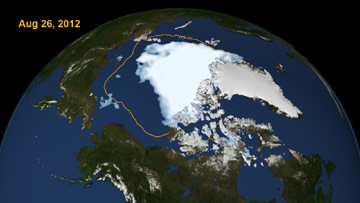290213-melting ice.jpg

This visualization shows the extent of Arctic sea ice in the fall of 2012. Credit: NASA
Many people get their hair trimmed a little closer to help beat the summer heat. And the same thing happens to our planet – the north polar ice cap gets trimmed as the weather gets warmer. In recent years, though, it’s as though the barber’s been out of control, with the ice cap cut farther back each year.
Earth’s warming climate is especially noticeable atop the Arctic Ocean, where warmer water and air temperatures are reducing the extent of the polar ice. The ice gets thicker during winter, when there’s no sunlight for months at a time. During summer, though, there’s constant sunshine, which melts the ice in a hurry.
Satellites have been keeping an eye on the north polar ice since 1979. Over that time, the area covered by the ice at the end of winter, in March, has dropped by about two-and-a-half percent per decade. But the area covered in September, at the end of summer, has dropped by 13 percent per decade. In September of 2012, the ice pack was the smallest yet seen.
The ice rebuilt over the winter. The readings in March of 2013 were below average, but not a record. But much of the ice was young and thin, suggesting that it will melt in a hurry under the summer Sun.
The loss of the ice cap has an impact on the entire planet. The ice reflects more than 90 percent of the sunlight that strikes it back into space, which helps keep Earth cool. But liquid water absorbs more solar energy than it reflects. So a smaller ice cap speeds the process of global warming – and trims the ice cap a little bit more.

